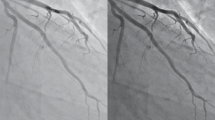Abstract
An indicator dilution method has been designed and applied to measure coronary flow rates in patients undergoing cardiac catheterization. It requires densitometric analysis of two particular angiographic sequences of the artery of interest, acquired digitally under specific conditions imposed on the contrast medium injections. The method was tested first on a simple artery model, and then on coronarography images obtained during routine examinations of patients. A comparative analysis between a group of patients having presumably normal flows and another group exhibiting slow dye progression (SDP) shows a moderate consistency between the method and the clinical assessments.





Similar content being viewed by others
References
Dernałowicz J, Goszczyńska H, Collorec R, Purzycki Z, Leszczyński L (1998) Theoretical and practical aspects of the volumetric global coronary blood flow measurements from one-plane coronarographic images. Pol J Med Phys Eng (Pol Soc Med Phys) 4:183–194
Dernałowicz J, Goszczyńska H, Mazur P (1996) Evaluation of indicator-dilution process in X-ray angiographic images deteriorated by factors of technical origin. Pol J Med Phys Eng (Pol Soc Med Phys) 2:163–175
Doriot PA, Dorsaz PA, Dorsaz L, Rutishauser WJ (1997) Is the indicator dilution theory really the adequate base of many blood flow measurement techniques? Med Phys 24:1889–1898
Dorsaz PA, Doriot PA, Dorsaz L, Chatelain P, Rutishauser W (1997) A new densitometric approach to the assessment of mean coronary flow. Invest Radiol 32:98–204
Ersahin A, Molloi S, Qian YJ (1994) Scatter and veiling glare corrections for quantitative digital subtraction angiography. In: Shaw R (ed) Medical imaging 1994: physics of medical imaging, SPIE Proc 2163, pp. 172–183
Goszczyńska H (2007) Movement tracking of artery segment in angiographic sequences by template matching method. In: Kurzynski M, Puchala E, Wozniak M, Zolnierek A (eds) Computer recognition systems 2, advances in soft computing. Springer, Berlin, pp 621–628
Goszczynska H, Bogorodzki P, Wolak T, Kurjata R, Orzechowski M (2004) Coronary blood flow measurement from X-rays images—experiment performed on the artery model. In: Nowakowski A, Kosmowski BB (eds) Optical methods, sensors, image processing, and visualization in medicine, SPIE Proc 5505, pp.157–163
Goszczyńska H, Dernałowicz J (2000) Correction of the physical and technical factors leading to deterioration in densitometric measurements performed on coronarographic films. Pol J Med Phys Eng (Pol Soc Med Phys) 6:91–100
Goszczyńska H (2004) Computer analysis of coronarographic images for coronary flow calculation (in Polish). PhD Thesis, Institute of Biocybernetics and Biomedical Engineering Polish Academy of Sciences, Warsaw
Goszczyńska H, Kowalczyk L, Rewicki M (2006) Clinical study of the coronary flow measurements method based on coronagrographic image sequences. Biocybern Biomed Eng (Pol Acad Sci) 26:63–73
Hofman MBM, Wickline SA, Lorenz CH (1998) Quantification of in-plane motion of the coronary arteries during the cardiac cycle: implications for acquisition window duration for MR flow quantification. J Magn Reson 8:568–576
Kern MJ, Lerman A, Bech JW, De Bruyne B, Eeckhout E, Fearon WF, Higano ST, Lim MJ, Meuwissen M, Piek JJ, Pijls NH, Siebes M, Spaan JA (2006) Physiological assessment of coronary artery disease in the cardiac catheterization laboratory: a scientific statement from the American Heart Association Committee on Diagnostic and Interventional Cardiac Catheterization, Council on Clinical Cardiology. Circulation 114:1321–1341
Mancini GB (1996) Application of digital angiography to the coronary circulation. In: Skorton D, Schelbert HR, Wolf GL, Brundage BH (eds) Marcus cardiac imaging. A companion to Braunwald’s heart disease. W.B. Saunders, Philadelphia, pp 325–347
Nissen SE, Gurley JC (1991) Application of indicator dilution principles to regional assessment of coronary flow reserve from digital angiography. In: Reiber JHC, Serruys PW (eds) Quantitative coronary angiography, vol 117. Kluwer, Dordrecht, pp 245–263
Ruiter H, Spaan JAE, Laird JD (1978) Transient oxygen uptake during myocardial reactive hyperemia in the dog. Am J Physiol Heart Circ Physiol 235(1):H87–H94
Scheuer-Leeser M, Morguet A, Reul H, Irnich W (1977) Some aspects to the pulsation error in blood-flow calculations by indicator-dilution techniques. Med Bio Eng Comput 15:118–123
Schrijver M (2002) Angiographic image analysis to assess the severity of coronary stenoses. PhD Thesis, Twente University Press, Enschede
Shpilfoygel SD, Close RA, Valentino DJ, Duckwiler GR (2000) X-ray videodensitometric methods for blood flow and velocity measurement: a critical review of literature. Med Phys 27:2008–2023
Simon R, Herrmann G, Amende I (1990) Comparison of three different principles in the assessment of coronary flow reserve from digital angiograms. Int J Cardiac Imaging 5:203–212
Spaan JA, Piek JJ, Hoffman JI, Siebes M (2006) Physiological basis of clinically used coronary hemodynamic indices. Review. Circulation 113:446–455
TIMI Study Group (1985) The thrombolysis in myocardial infarction (TIMI) trial. N Engl J Med 31:932–936
Acknowledgments
This research was supported by Ministry of Science and Higher Education grant No1464/T11/2001/20. Published in part in Biocybernetics and Biomedical Engineering, Polish Academy of Sciences (2006), 26:63–73 (with permission).
Author information
Authors and Affiliations
Corresponding author
Rights and permissions
About this article
Cite this article
Goszczyńska, H., Rewicki, M. Coronary flow evaluation by densitometric analysis of sequences of coronarographic images. Med Bio Eng Comput 46, 199–204 (2008). https://doi.org/10.1007/s11517-007-0288-5
Received:
Accepted:
Published:
Issue Date:
DOI: https://doi.org/10.1007/s11517-007-0288-5




